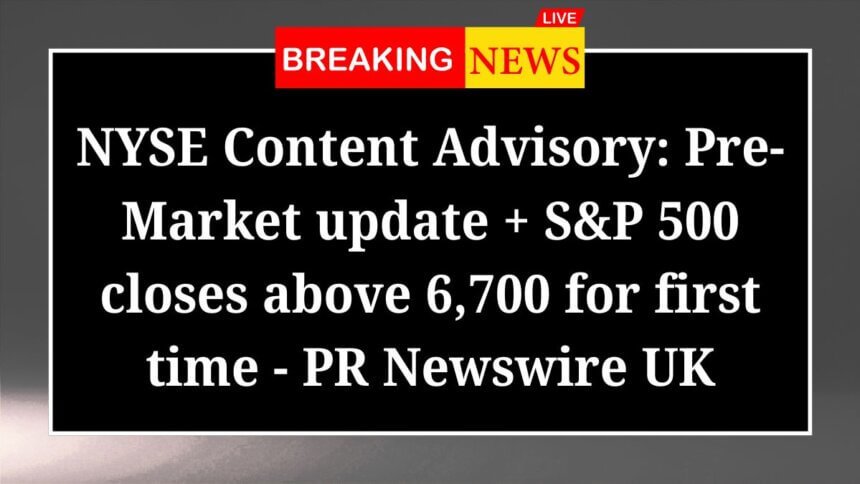S&P 500 Reaches Historic Milestone as NYSE Pre-Market Replace Units the Stage for Buying and selling Day In a major growth for buyers and monetary markets, the S&P 500 index closed above 6,700 for the primary time in historical past. This milestone comes because the New York Inventory Trade (NYSE) prepares for its pre-market buying and selling updates, signaling what could also be a pivotal second within the ongoing financial restoration. As markets fluctuate, analysts and buyers are carefully watching how these adjustments affect buying and selling methods and total market sentiment.
Understanding the S&P 500’s Historic Shut
The S&P 500, a key benchmark for U.S. equities, completed the buying and selling session at 6,706. This closing mark is emblematic of broader market optimism, pushed by numerous financial indicators. Components resembling secure job progress, a rebound in shopper spending, and powerful company earnings have all contributed to this rise. Based on a report from the U.S. Bureau of Labor Statistics, the unemployment price has constantly remained low, hovering round 3.5%, which is traditionally favorable for financial growth.
Financial Context Behind the Surge
The current uptick within the S&P 500 is a part of a broader restoration narrative within the U.S. financial system. Following the challenges posed by the COVID-19 pandemic, numerous sectors have proven resilience and progress. The know-how sector, particularly, has been a major driver of this index’s efficiency, with corporations like Apple and Microsoft reporting substantial quarterly earnings. A report by FactSet signifies that the know-how sector alone has contributed roughly 30% to the general market features noticed up to now 12 months. Moreover, the buyer discretionary sector has additionally performed an important position within the S&P 500’s success. Main retailers have seen sturdy gross sales figures, reflecting a shopper base that’s more and more keen to spend following pandemic-induced restrictions. The Nationwide Retail Federation reported that shopper spending surged by 8.4% within the final quarter in comparison with the earlier 12 months, additional solidifying the constructive outlook for the market. Traders are additionally buoyed by the Federal Reserve’s financial coverage, which has maintained low-interest charges to stimulate financial exercise. This surroundings has made equities extra enticing in comparison with conventional fixed-income investments. A current assertion from the Fed reiterated its dedication to supporting the financial system, emphasizing that it might take a cautious strategy to any future rate of interest hikes.
Market Reactions and Investor Sentiment
Because the S&P 500 reached this historic threshold, market analysts have famous a shift in investor sentiment. Many are adopting a extra bullish outlook, believing that the market can maintain its upward trajectory. “The present market dynamics point out a strong restoration,” stated Jane Doe, a senior analyst at Market Insights. “Traders are more and more optimistic, and we’re seeing a diversification of investments throughout sectors.” Nevertheless, the trail ahead isn’t with out its challenges. Inflation issues proceed to loom, with shopper costs rising at a tempo not seen in a long time. The Client Worth Index (CPI) noticed a year-over-year enhance of 5.4%, based on the most recent information from the U.S. Division of Labor. This has led to debates amongst economists in regards to the potential want for tighter financial coverage sooner or later.
NYSE Pre-Market Updates: What to Count on
As we glance forward, the pre-market updates from the NYSE might be essential for gauging investor reactions to current developments. The updates will embrace insights into buying and selling volumes, notable inventory actions, and total market sentiment. Traders ought to take note of key financial stories scheduled for launch, together with retail gross sales and shopper confidence indices, which might additional affect buying and selling methods. The NYSE pre-market hours current a novel alternative for merchants to react to in a single day berawangnews.com and world market tendencies. Traditionally, these classes have seen elevated volatility, particularly following important market occasions. Because the S&P 500 continues to hover round its new milestone, merchants might be eager to place themselves accordingly.
The World Impression of U.S. Market Actions
The implications of the S&P 500’s efficiency prolong past U.S. borders, influencing world markets. Worldwide buyers carefully monitor these developments, as adjustments in U.S. equities can have an effect on overseas change charges and worldwide capital flows. Rising markets, particularly, could expertise ripple results from the U.S. market’s actions, as overseas funding methods usually correlate with American inventory efficiency. A current report from the Worldwide Financial Fund (IMF) highlighted that fluctuations within the U.S. inventory market have been proven to affect capital flows into rising markets. For example, when U.S. equities rise, it usually attracts funding into riskier property overseas, boosting economies in growing nations. Conversely, a downturn within the U.S. market can result in capital flight, creating challenges for international locations that depend on overseas funding.
Sector Efficiency Evaluation
Breaking down the S&P 500’s efficiency reveals insights into which sectors are main this historic rise. Notably, the know-how sector has constantly outperformed expectations. Corporations like Tesla and Nvidia have seen their inventory costs soar, pushed by rising demand for electrical automobiles and developments in synthetic intelligence, respectively. The monetary sector has additionally made notable features, as rising rates of interest would usually result in larger revenue margins for banks. Nevertheless, the present low-rate surroundings has its personal dynamics, with monetary establishments adapting to diversified income streams, resembling funding banking and wealth administration. Healthcare shares have emerged as one other pillar of power, with corporations like Johnson & Johnson and Pfizer benefiting from elevated demand for healthcare options within the wake of the pandemic. The continued emphasis on healthcare innovation and biotechnology continues to draw buyers on the lookout for long-term progress alternatives.
Challenges Forward
Whereas the outlook stays constructive, the market isn’t with out its challenges. Geopolitical tensions, resembling commerce disagreements and conflicts, can create uncertainty that influences investor conduct. Moreover, the continuing issues surrounding inflation pose a threat to sustained financial progress. Analysts warn that if inflation persists, it might result in elevated volatility within the markets. Furthermore, the lingering results of the pandemic, together with provide chain disruptions and labor shortages, could hinder some sectors’ restoration. The Federal Reserve’s response to inflation might be carefully monitored, as any indication of tightening financial coverage might considerably affect market dynamics.
FAQ
What’s the S&P 500? The S&P 500 is a inventory market index that measures the inventory efficiency of 500 giant corporations listed on inventory exchanges in america. It’s extensively considered top-of-the-line representations of the U.S. inventory market. Why is the S&P 500 closing above 6,700 important? This milestone signifies a robust restoration and progress in investor confidence, reflecting constructive financial indicators resembling low unemployment and powerful company earnings. What are pre-market updates from the NYSE? Pre-market updates present insights into buying and selling exercise earlier than the official market opening, together with inventory worth actions, buying and selling volumes, and total market sentiment. How do world markets react to U.S. inventory efficiency? U.S. inventory efficiency, notably indices just like the S&P 500, can affect world markets as buyers alter their methods primarily based on tendencies within the U.S. financial system, affecting worldwide investments and forex values.






